Reasons Why People Take Drugs: Sociological and Psychological Analysis
VerifiedAdded on 2021/02/21
|10
|3470
|267
Essay
AI Summary
This essay provides a comprehensive analysis of the reasons why individuals consume drugs. It explores the sociological, economic, geographic, and historical contexts of drug use, including prevalence rates, hospital admissions, and deaths related to drug misuse. The essay delves into the psychological factors driving drug use, such as the desire to feel good, alleviate stress, enhance performance, and succumb to social pressures and curiosity. It also examines different types of drug use and drug-using behaviors, including stimulant and heroin abuse, and discusses the impact of drugs on society. Furthermore, the essay explores the normalization theory and the moral and psychological models of addiction, providing a nuanced understanding of the complex factors that contribute to substance abuse. The paper is a contribution to Desklib, a platform offering AI-based study tools for students.

Critically analyze the reasons
why people take drugs
why people take drugs
Paraphrase This Document
Need a fresh take? Get an instant paraphrase of this document with our AI Paraphraser
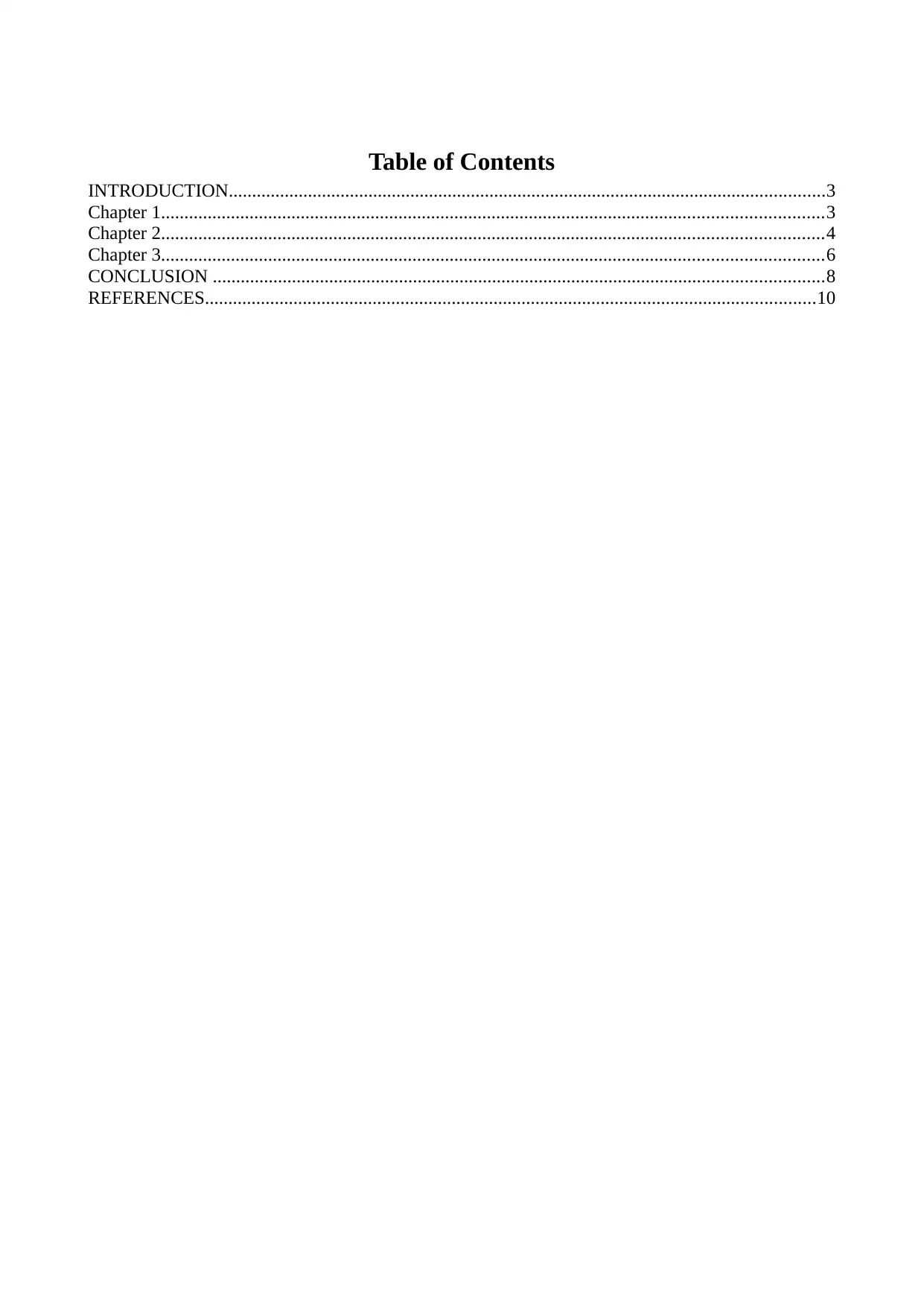
Table of Contents
INTRODUCTION................................................................................................................................3
Chapter 1..............................................................................................................................................3
Chapter 2..............................................................................................................................................4
Chapter 3..............................................................................................................................................6
CONCLUSION ...................................................................................................................................8
REFERENCES...................................................................................................................................10
INTRODUCTION................................................................................................................................3
Chapter 1..............................................................................................................................................3
Chapter 2..............................................................................................................................................4
Chapter 3..............................................................................................................................................6
CONCLUSION ...................................................................................................................................8
REFERENCES...................................................................................................................................10
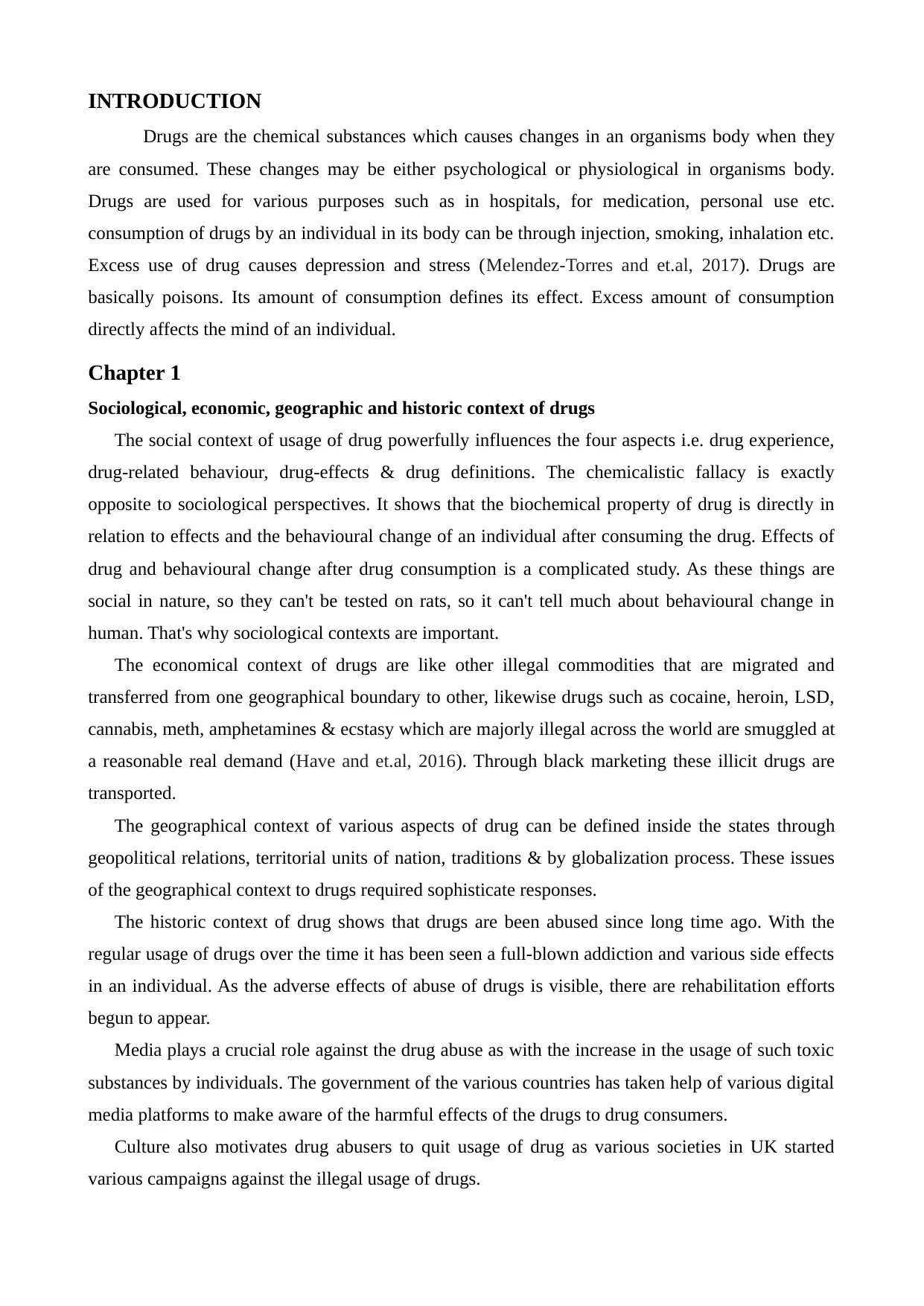
INTRODUCTION
Drugs are the chemical substances which causes changes in an organisms body when they
are consumed. These changes may be either psychological or physiological in organisms body.
Drugs are used for various purposes such as in hospitals, for medication, personal use etc.
consumption of drugs by an individual in its body can be through injection, smoking, inhalation etc.
Excess use of drug causes depression and stress (Melendez-Torres and et.al, 2017). Drugs are
basically poisons. Its amount of consumption defines its effect. Excess amount of consumption
directly affects the mind of an individual.
Chapter 1
Sociological, economic, geographic and historic context of drugs
The social context of usage of drug powerfully influences the four aspects i.e. drug experience,
drug-related behaviour, drug-effects & drug definitions. The chemicalistic fallacy is exactly
opposite to sociological perspectives. It shows that the biochemical property of drug is directly in
relation to effects and the behavioural change of an individual after consuming the drug. Effects of
drug and behavioural change after drug consumption is a complicated study. As these things are
social in nature, so they can't be tested on rats, so it can't tell much about behavioural change in
human. That's why sociological contexts are important.
The economical context of drugs are like other illegal commodities that are migrated and
transferred from one geographical boundary to other, likewise drugs such as cocaine, heroin, LSD,
cannabis, meth, amphetamines & ecstasy which are majorly illegal across the world are smuggled at
a reasonable real demand (Have and et.al, 2016). Through black marketing these illicit drugs are
transported.
The geographical context of various aspects of drug can be defined inside the states through
geopolitical relations, territorial units of nation, traditions & by globalization process. These issues
of the geographical context to drugs required sophisticate responses.
The historic context of drug shows that drugs are been abused since long time ago. With the
regular usage of drugs over the time it has been seen a full-blown addiction and various side effects
in an individual. As the adverse effects of abuse of drugs is visible, there are rehabilitation efforts
begun to appear.
Media plays a crucial role against the drug abuse as with the increase in the usage of such toxic
substances by individuals. The government of the various countries has taken help of various digital
media platforms to make aware of the harmful effects of the drugs to drug consumers.
Culture also motivates drug abusers to quit usage of drug as various societies in UK started
various campaigns against the illegal usage of drugs.
Drugs are the chemical substances which causes changes in an organisms body when they
are consumed. These changes may be either psychological or physiological in organisms body.
Drugs are used for various purposes such as in hospitals, for medication, personal use etc.
consumption of drugs by an individual in its body can be through injection, smoking, inhalation etc.
Excess use of drug causes depression and stress (Melendez-Torres and et.al, 2017). Drugs are
basically poisons. Its amount of consumption defines its effect. Excess amount of consumption
directly affects the mind of an individual.
Chapter 1
Sociological, economic, geographic and historic context of drugs
The social context of usage of drug powerfully influences the four aspects i.e. drug experience,
drug-related behaviour, drug-effects & drug definitions. The chemicalistic fallacy is exactly
opposite to sociological perspectives. It shows that the biochemical property of drug is directly in
relation to effects and the behavioural change of an individual after consuming the drug. Effects of
drug and behavioural change after drug consumption is a complicated study. As these things are
social in nature, so they can't be tested on rats, so it can't tell much about behavioural change in
human. That's why sociological contexts are important.
The economical context of drugs are like other illegal commodities that are migrated and
transferred from one geographical boundary to other, likewise drugs such as cocaine, heroin, LSD,
cannabis, meth, amphetamines & ecstasy which are majorly illegal across the world are smuggled at
a reasonable real demand (Have and et.al, 2016). Through black marketing these illicit drugs are
transported.
The geographical context of various aspects of drug can be defined inside the states through
geopolitical relations, territorial units of nation, traditions & by globalization process. These issues
of the geographical context to drugs required sophisticate responses.
The historic context of drug shows that drugs are been abused since long time ago. With the
regular usage of drugs over the time it has been seen a full-blown addiction and various side effects
in an individual. As the adverse effects of abuse of drugs is visible, there are rehabilitation efforts
begun to appear.
Media plays a crucial role against the drug abuse as with the increase in the usage of such toxic
substances by individuals. The government of the various countries has taken help of various digital
media platforms to make aware of the harmful effects of the drugs to drug consumers.
Culture also motivates drug abusers to quit usage of drug as various societies in UK started
various campaigns against the illegal usage of drugs.
⊘ This is a preview!⊘
Do you want full access?
Subscribe today to unlock all pages.

Trusted by 1+ million students worldwide
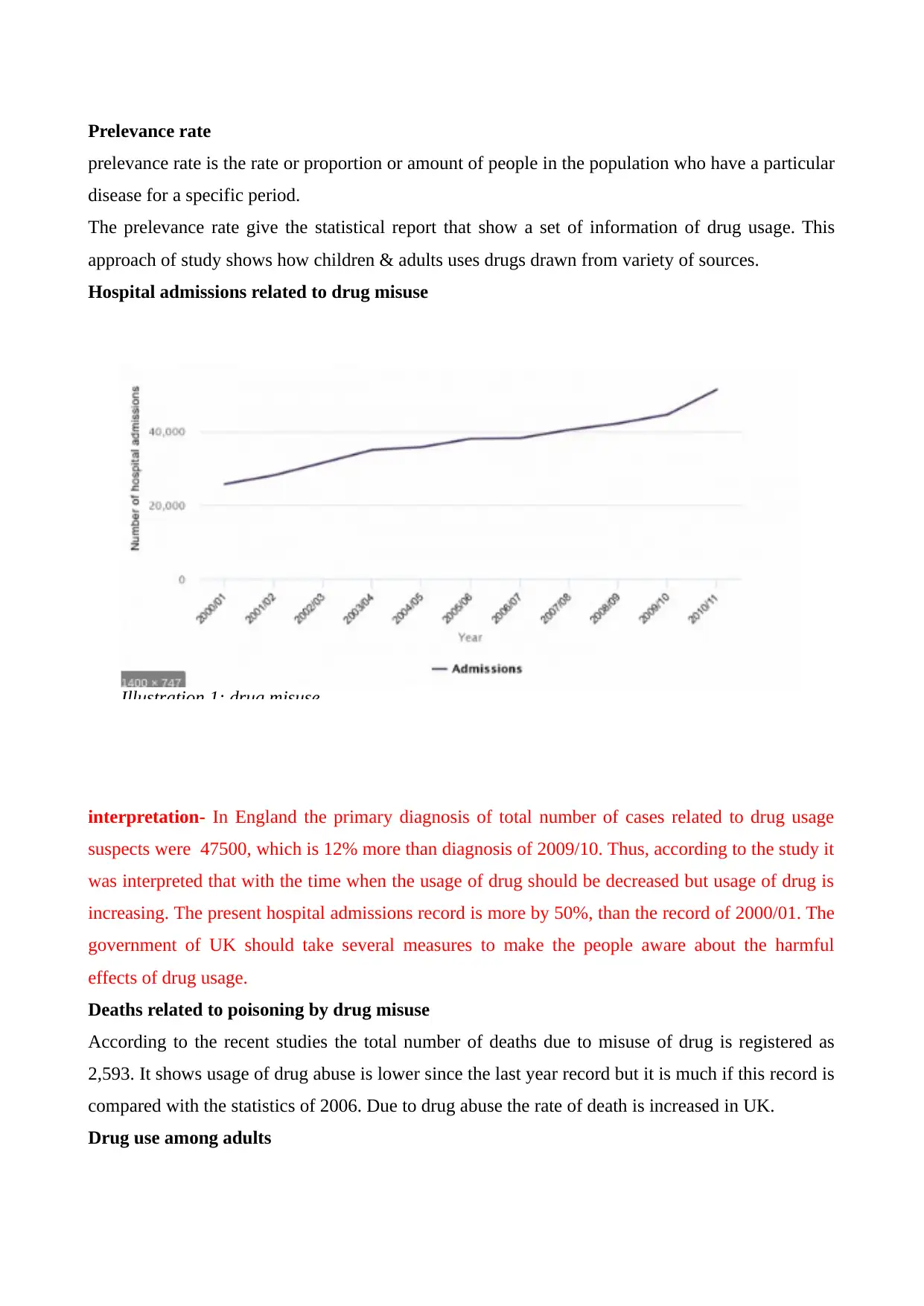
Prelevance rate
prelevance rate is the rate or proportion or amount of people in the population who have a particular
disease for a specific period.
The prelevance rate give the statistical report that show a set of information of drug usage. This
approach of study shows how children & adults uses drugs drawn from variety of sources.
Hospital admissions related to drug misuse
interpretation- In England the primary diagnosis of total number of cases related to drug usage
suspects were 47500, which is 12% more than diagnosis of 2009/10. Thus, according to the study it
was interpreted that with the time when the usage of drug should be decreased but usage of drug is
increasing. The present hospital admissions record is more by 50%, than the record of 2000/01. The
government of UK should take several measures to make the people aware about the harmful
effects of drug usage.
Deaths related to poisoning by drug misuse
According to the recent studies the total number of deaths due to misuse of drug is registered as
2,593. It shows usage of drug abuse is lower since the last year record but it is much if this record is
compared with the statistics of 2006. Due to drug abuse the rate of death is increased in UK.
Drug use among adults
Illustration 1: drug misuse
prelevance rate is the rate or proportion or amount of people in the population who have a particular
disease for a specific period.
The prelevance rate give the statistical report that show a set of information of drug usage. This
approach of study shows how children & adults uses drugs drawn from variety of sources.
Hospital admissions related to drug misuse
interpretation- In England the primary diagnosis of total number of cases related to drug usage
suspects were 47500, which is 12% more than diagnosis of 2009/10. Thus, according to the study it
was interpreted that with the time when the usage of drug should be decreased but usage of drug is
increasing. The present hospital admissions record is more by 50%, than the record of 2000/01. The
government of UK should take several measures to make the people aware about the harmful
effects of drug usage.
Deaths related to poisoning by drug misuse
According to the recent studies the total number of deaths due to misuse of drug is registered as
2,593. It shows usage of drug abuse is lower since the last year record but it is much if this record is
compared with the statistics of 2006. Due to drug abuse the rate of death is increased in UK.
Drug use among adults
Illustration 1: drug misuse
Paraphrase This Document
Need a fresh take? Get an instant paraphrase of this document with our AI Paraphraser
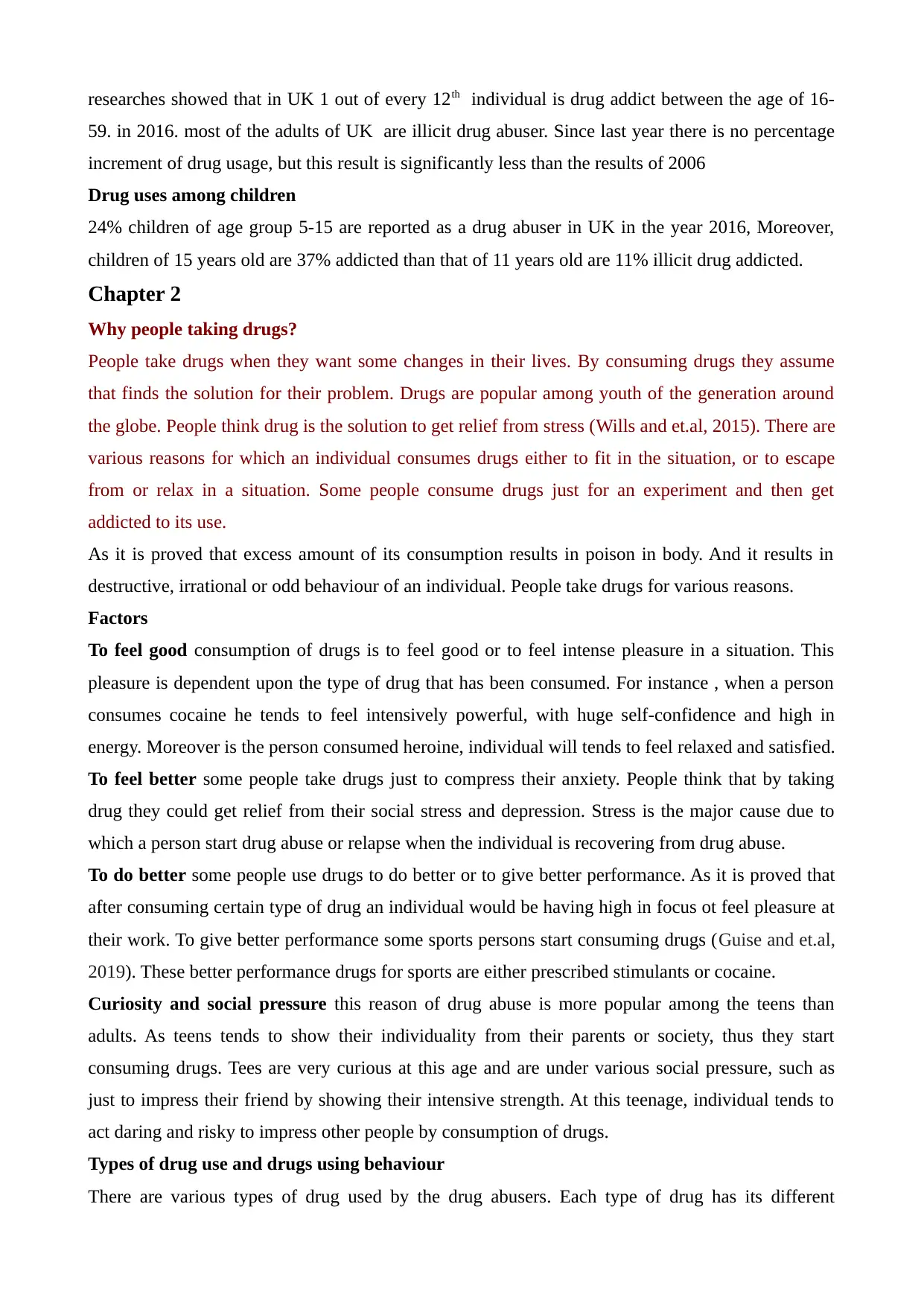
researches showed that in UK 1 out of every 12th individual is drug addict between the age of 16-
59. in 2016. most of the adults of UK are illicit drug abuser. Since last year there is no percentage
increment of drug usage, but this result is significantly less than the results of 2006
Drug uses among children
24% children of age group 5-15 are reported as a drug abuser in UK in the year 2016, Moreover,
children of 15 years old are 37% addicted than that of 11 years old are 11% illicit drug addicted.
Chapter 2
Why people taking drugs?
People take drugs when they want some changes in their lives. By consuming drugs they assume
that finds the solution for their problem. Drugs are popular among youth of the generation around
the globe. People think drug is the solution to get relief from stress (Wills and et.al, 2015). There are
various reasons for which an individual consumes drugs either to fit in the situation, or to escape
from or relax in a situation. Some people consume drugs just for an experiment and then get
addicted to its use.
As it is proved that excess amount of its consumption results in poison in body. And it results in
destructive, irrational or odd behaviour of an individual. People take drugs for various reasons.
Factors
To feel good consumption of drugs is to feel good or to feel intense pleasure in a situation. This
pleasure is dependent upon the type of drug that has been consumed. For instance , when a person
consumes cocaine he tends to feel intensively powerful, with huge self-confidence and high in
energy. Moreover is the person consumed heroine, individual will tends to feel relaxed and satisfied.
To feel better some people take drugs just to compress their anxiety. People think that by taking
drug they could get relief from their social stress and depression. Stress is the major cause due to
which a person start drug abuse or relapse when the individual is recovering from drug abuse.
To do better some people use drugs to do better or to give better performance. As it is proved that
after consuming certain type of drug an individual would be having high in focus ot feel pleasure at
their work. To give better performance some sports persons start consuming drugs (Guise and et.al,
2019). These better performance drugs for sports are either prescribed stimulants or cocaine.
Curiosity and social pressure this reason of drug abuse is more popular among the teens than
adults. As teens tends to show their individuality from their parents or society, thus they start
consuming drugs. Tees are very curious at this age and are under various social pressure, such as
just to impress their friend by showing their intensive strength. At this teenage, individual tends to
act daring and risky to impress other people by consumption of drugs.
Types of drug use and drugs using behaviour
There are various types of drug used by the drug abusers. Each type of drug has its different
59. in 2016. most of the adults of UK are illicit drug abuser. Since last year there is no percentage
increment of drug usage, but this result is significantly less than the results of 2006
Drug uses among children
24% children of age group 5-15 are reported as a drug abuser in UK in the year 2016, Moreover,
children of 15 years old are 37% addicted than that of 11 years old are 11% illicit drug addicted.
Chapter 2
Why people taking drugs?
People take drugs when they want some changes in their lives. By consuming drugs they assume
that finds the solution for their problem. Drugs are popular among youth of the generation around
the globe. People think drug is the solution to get relief from stress (Wills and et.al, 2015). There are
various reasons for which an individual consumes drugs either to fit in the situation, or to escape
from or relax in a situation. Some people consume drugs just for an experiment and then get
addicted to its use.
As it is proved that excess amount of its consumption results in poison in body. And it results in
destructive, irrational or odd behaviour of an individual. People take drugs for various reasons.
Factors
To feel good consumption of drugs is to feel good or to feel intense pleasure in a situation. This
pleasure is dependent upon the type of drug that has been consumed. For instance , when a person
consumes cocaine he tends to feel intensively powerful, with huge self-confidence and high in
energy. Moreover is the person consumed heroine, individual will tends to feel relaxed and satisfied.
To feel better some people take drugs just to compress their anxiety. People think that by taking
drug they could get relief from their social stress and depression. Stress is the major cause due to
which a person start drug abuse or relapse when the individual is recovering from drug abuse.
To do better some people use drugs to do better or to give better performance. As it is proved that
after consuming certain type of drug an individual would be having high in focus ot feel pleasure at
their work. To give better performance some sports persons start consuming drugs (Guise and et.al,
2019). These better performance drugs for sports are either prescribed stimulants or cocaine.
Curiosity and social pressure this reason of drug abuse is more popular among the teens than
adults. As teens tends to show their individuality from their parents or society, thus they start
consuming drugs. Tees are very curious at this age and are under various social pressure, such as
just to impress their friend by showing their intensive strength. At this teenage, individual tends to
act daring and risky to impress other people by consumption of drugs.
Types of drug use and drugs using behaviour
There are various types of drug used by the drug abusers. Each type of drug has its different
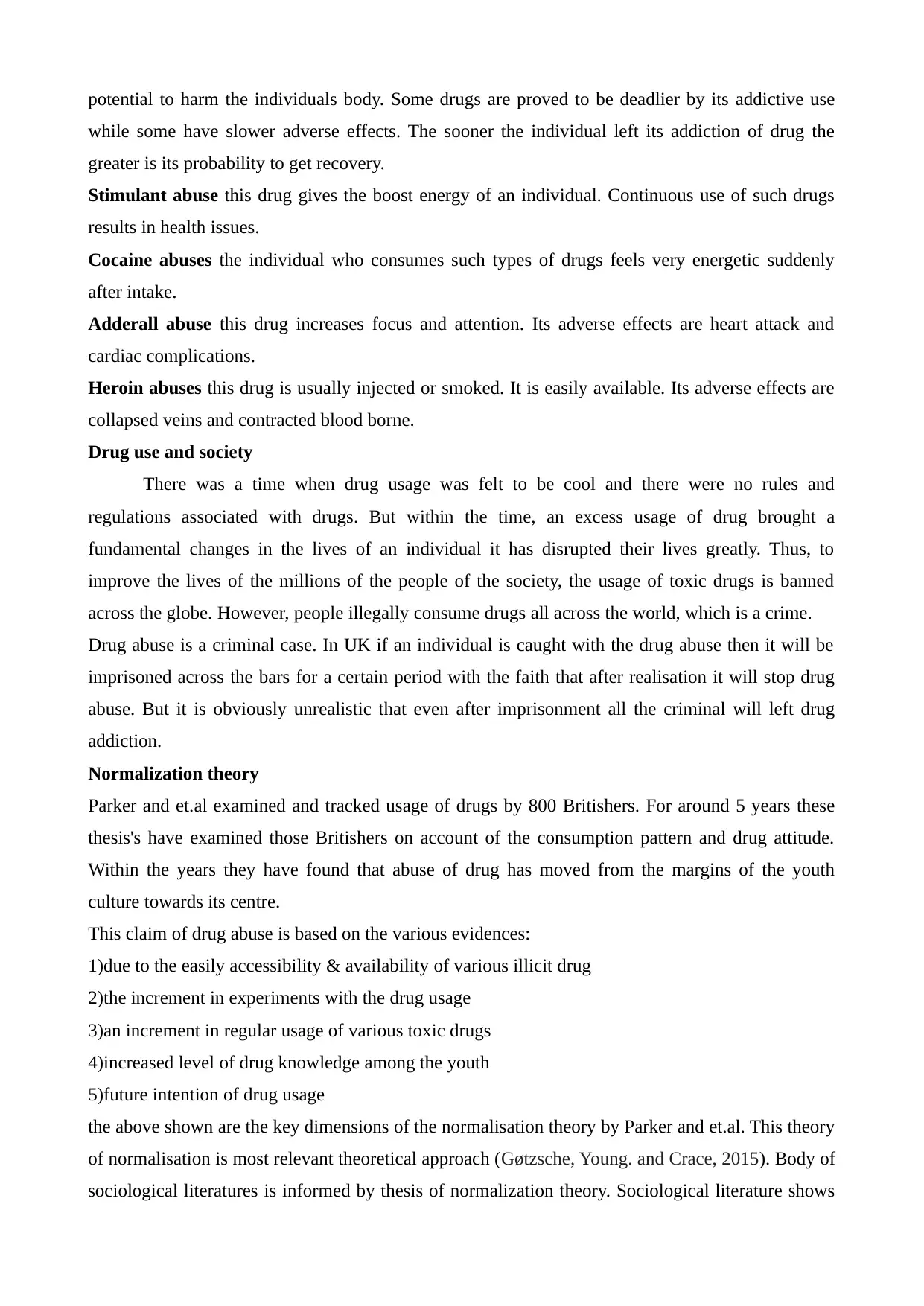
potential to harm the individuals body. Some drugs are proved to be deadlier by its addictive use
while some have slower adverse effects. The sooner the individual left its addiction of drug the
greater is its probability to get recovery.
Stimulant abuse this drug gives the boost energy of an individual. Continuous use of such drugs
results in health issues.
Cocaine abuses the individual who consumes such types of drugs feels very energetic suddenly
after intake.
Adderall abuse this drug increases focus and attention. Its adverse effects are heart attack and
cardiac complications.
Heroin abuses this drug is usually injected or smoked. It is easily available. Its adverse effects are
collapsed veins and contracted blood borne.
Drug use and society
There was a time when drug usage was felt to be cool and there were no rules and
regulations associated with drugs. But within the time, an excess usage of drug brought a
fundamental changes in the lives of an individual it has disrupted their lives greatly. Thus, to
improve the lives of the millions of the people of the society, the usage of toxic drugs is banned
across the globe. However, people illegally consume drugs all across the world, which is a crime.
Drug abuse is a criminal case. In UK if an individual is caught with the drug abuse then it will be
imprisoned across the bars for a certain period with the faith that after realisation it will stop drug
abuse. But it is obviously unrealistic that even after imprisonment all the criminal will left drug
addiction.
Normalization theory
Parker and et.al examined and tracked usage of drugs by 800 Britishers. For around 5 years these
thesis's have examined those Britishers on account of the consumption pattern and drug attitude.
Within the years they have found that abuse of drug has moved from the margins of the youth
culture towards its centre.
This claim of drug abuse is based on the various evidences:
1)due to the easily accessibility & availability of various illicit drug
2)the increment in experiments with the drug usage
3)an increment in regular usage of various toxic drugs
4)increased level of drug knowledge among the youth
5)future intention of drug usage
the above shown are the key dimensions of the normalisation theory by Parker and et.al. This theory
of normalisation is most relevant theoretical approach (Gøtzsche, Young. and Crace, 2015). Body of
sociological literatures is informed by thesis of normalization theory. Sociological literature shows
while some have slower adverse effects. The sooner the individual left its addiction of drug the
greater is its probability to get recovery.
Stimulant abuse this drug gives the boost energy of an individual. Continuous use of such drugs
results in health issues.
Cocaine abuses the individual who consumes such types of drugs feels very energetic suddenly
after intake.
Adderall abuse this drug increases focus and attention. Its adverse effects are heart attack and
cardiac complications.
Heroin abuses this drug is usually injected or smoked. It is easily available. Its adverse effects are
collapsed veins and contracted blood borne.
Drug use and society
There was a time when drug usage was felt to be cool and there were no rules and
regulations associated with drugs. But within the time, an excess usage of drug brought a
fundamental changes in the lives of an individual it has disrupted their lives greatly. Thus, to
improve the lives of the millions of the people of the society, the usage of toxic drugs is banned
across the globe. However, people illegally consume drugs all across the world, which is a crime.
Drug abuse is a criminal case. In UK if an individual is caught with the drug abuse then it will be
imprisoned across the bars for a certain period with the faith that after realisation it will stop drug
abuse. But it is obviously unrealistic that even after imprisonment all the criminal will left drug
addiction.
Normalization theory
Parker and et.al examined and tracked usage of drugs by 800 Britishers. For around 5 years these
thesis's have examined those Britishers on account of the consumption pattern and drug attitude.
Within the years they have found that abuse of drug has moved from the margins of the youth
culture towards its centre.
This claim of drug abuse is based on the various evidences:
1)due to the easily accessibility & availability of various illicit drug
2)the increment in experiments with the drug usage
3)an increment in regular usage of various toxic drugs
4)increased level of drug knowledge among the youth
5)future intention of drug usage
the above shown are the key dimensions of the normalisation theory by Parker and et.al. This theory
of normalisation is most relevant theoretical approach (Gøtzsche, Young. and Crace, 2015). Body of
sociological literatures is informed by thesis of normalization theory. Sociological literature shows
⊘ This is a preview!⊘
Do you want full access?
Subscribe today to unlock all pages.

Trusted by 1+ million students worldwide
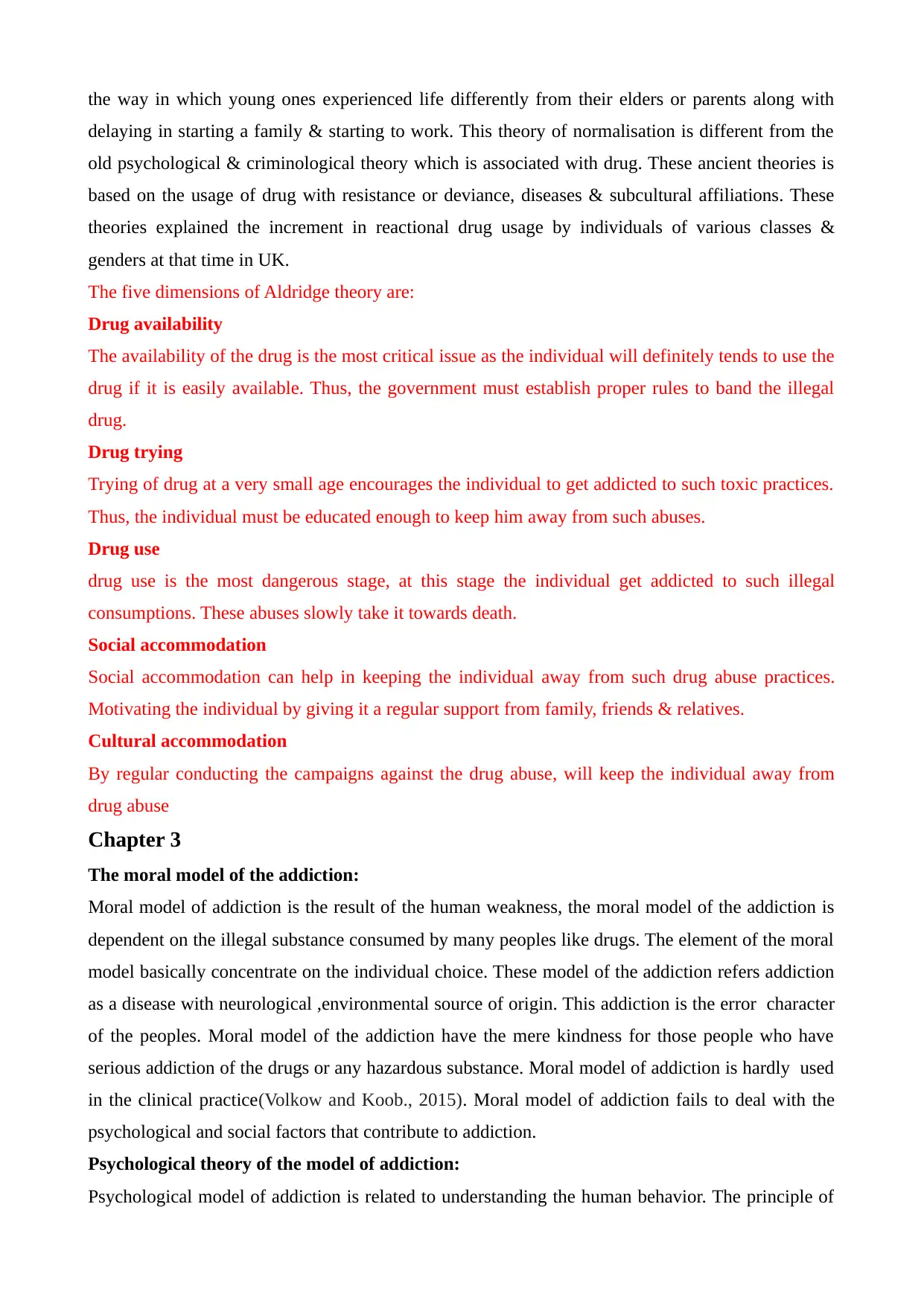
the way in which young ones experienced life differently from their elders or parents along with
delaying in starting a family & starting to work. This theory of normalisation is different from the
old psychological & criminological theory which is associated with drug. These ancient theories is
based on the usage of drug with resistance or deviance, diseases & subcultural affiliations. These
theories explained the increment in reactional drug usage by individuals of various classes &
genders at that time in UK.
The five dimensions of Aldridge theory are:
Drug availability
The availability of the drug is the most critical issue as the individual will definitely tends to use the
drug if it is easily available. Thus, the government must establish proper rules to band the illegal
drug.
Drug trying
Trying of drug at a very small age encourages the individual to get addicted to such toxic practices.
Thus, the individual must be educated enough to keep him away from such abuses.
Drug use
drug use is the most dangerous stage, at this stage the individual get addicted to such illegal
consumptions. These abuses slowly take it towards death.
Social accommodation
Social accommodation can help in keeping the individual away from such drug abuse practices.
Motivating the individual by giving it a regular support from family, friends & relatives.
Cultural accommodation
By regular conducting the campaigns against the drug abuse, will keep the individual away from
drug abuse
Chapter 3
The moral model of the addiction:
Moral model of addiction is the result of the human weakness, the moral model of the addiction is
dependent on the illegal substance consumed by many peoples like drugs. The element of the moral
model basically concentrate on the individual choice. These model of the addiction refers addiction
as a disease with neurological ,environmental source of origin. This addiction is the error character
of the peoples. Moral model of the addiction have the mere kindness for those people who have
serious addiction of the drugs or any hazardous substance. Moral model of addiction is hardly used
in the clinical practice(Volkow and Koob., 2015). Moral model of addiction fails to deal with the
psychological and social factors that contribute to addiction.
Psychological theory of the model of addiction:
Psychological model of addiction is related to understanding the human behavior. The principle of
delaying in starting a family & starting to work. This theory of normalisation is different from the
old psychological & criminological theory which is associated with drug. These ancient theories is
based on the usage of drug with resistance or deviance, diseases & subcultural affiliations. These
theories explained the increment in reactional drug usage by individuals of various classes &
genders at that time in UK.
The five dimensions of Aldridge theory are:
Drug availability
The availability of the drug is the most critical issue as the individual will definitely tends to use the
drug if it is easily available. Thus, the government must establish proper rules to band the illegal
drug.
Drug trying
Trying of drug at a very small age encourages the individual to get addicted to such toxic practices.
Thus, the individual must be educated enough to keep him away from such abuses.
Drug use
drug use is the most dangerous stage, at this stage the individual get addicted to such illegal
consumptions. These abuses slowly take it towards death.
Social accommodation
Social accommodation can help in keeping the individual away from such drug abuse practices.
Motivating the individual by giving it a regular support from family, friends & relatives.
Cultural accommodation
By regular conducting the campaigns against the drug abuse, will keep the individual away from
drug abuse
Chapter 3
The moral model of the addiction:
Moral model of addiction is the result of the human weakness, the moral model of the addiction is
dependent on the illegal substance consumed by many peoples like drugs. The element of the moral
model basically concentrate on the individual choice. These model of the addiction refers addiction
as a disease with neurological ,environmental source of origin. This addiction is the error character
of the peoples. Moral model of the addiction have the mere kindness for those people who have
serious addiction of the drugs or any hazardous substance. Moral model of addiction is hardly used
in the clinical practice(Volkow and Koob., 2015). Moral model of addiction fails to deal with the
psychological and social factors that contribute to addiction.
Psychological theory of the model of addiction:
Psychological model of addiction is related to understanding the human behavior. The principle of
Paraphrase This Document
Need a fresh take? Get an instant paraphrase of this document with our AI Paraphraser

the psychological theory devote to the overall development of many theories related to the
substance use addiction. Psychological theories of the model of addiction had influence on peoples
understanding of the cause of the addiction. Psychological model of addiction looks the mental
disorders of the peoples or individuals as the cause of the addiction, these disorders of the
psychological include mood disturbance and other mental illnesses of the individuals. Psychological
model of addiction are commonly also known as the psycho-pathological model of addiction. This
theory of the model of the addiction would try to analysis and resolve underlying Psychological
disorder, This includes improving of the persons cognitive and emotional functioning and
reconstructing the personality of the peoples. Psychological model of addiction include the operant
and classical conditioning principles (Hall,Carter and Forlini., 2015).
Operant conditioning is totally related to the rewards and the punishment. Peoples who use the
drugs for the first time they enjoy the feelings of the drugs which is created by consuming drugs by
them. This is the positive reinforcement similarly negative reinforcement is like peoples found that
consumption of drug decreases there negative feelings like pain , low mood , mood swings etc.
The classical conditioning is the process or role which helps to explain that why sensation
originating from inside the body generally trigger a persons craving for a substance.
The personality models of the addiction:
These model is related to the psychological model of the addiction under this personality is defined
as the set of behaviours and emotion of an individual. This approach to addiction explore the
chemical dependency as rooted in abnormalities of personality, presence of the obsessive
personality in some individual and their traits of low self-esteem, inability to cope with stress and
powerless all contribute to their addiction (Lüscher., 2016).
The social education model of addiction:
Social education model of addiction represent to the approach which borrows principle from the
classical conditioning and operant conditioning, under which addiction is clear as the learned
behavior or nature stemming from, influences modelling, cognitive processes as well as genetic
influences. This model place an emphasis on human environment interaction as key to shaping
addiction behavior of the peoples.
Impact of youth culture, normalisation, social structural issues, globalisation, polydrug and
media/education
The impact of drug on youth culture can be explained in many ways. The usage of drug is
always dependent on culture (Humphreys, 2017). Different country culture has their own way of
drug usage. The first significant drug culture was found in mid 1960's. The drugs that are used at
this time were cannabis & LSD s. However, after some time the usage of drug got decreased but it
is called the first wave of drug. Drug has largely affected the youth of UK, around every 12
substance use addiction. Psychological theories of the model of addiction had influence on peoples
understanding of the cause of the addiction. Psychological model of addiction looks the mental
disorders of the peoples or individuals as the cause of the addiction, these disorders of the
psychological include mood disturbance and other mental illnesses of the individuals. Psychological
model of addiction are commonly also known as the psycho-pathological model of addiction. This
theory of the model of the addiction would try to analysis and resolve underlying Psychological
disorder, This includes improving of the persons cognitive and emotional functioning and
reconstructing the personality of the peoples. Psychological model of addiction include the operant
and classical conditioning principles (Hall,Carter and Forlini., 2015).
Operant conditioning is totally related to the rewards and the punishment. Peoples who use the
drugs for the first time they enjoy the feelings of the drugs which is created by consuming drugs by
them. This is the positive reinforcement similarly negative reinforcement is like peoples found that
consumption of drug decreases there negative feelings like pain , low mood , mood swings etc.
The classical conditioning is the process or role which helps to explain that why sensation
originating from inside the body generally trigger a persons craving for a substance.
The personality models of the addiction:
These model is related to the psychological model of the addiction under this personality is defined
as the set of behaviours and emotion of an individual. This approach to addiction explore the
chemical dependency as rooted in abnormalities of personality, presence of the obsessive
personality in some individual and their traits of low self-esteem, inability to cope with stress and
powerless all contribute to their addiction (Lüscher., 2016).
The social education model of addiction:
Social education model of addiction represent to the approach which borrows principle from the
classical conditioning and operant conditioning, under which addiction is clear as the learned
behavior or nature stemming from, influences modelling, cognitive processes as well as genetic
influences. This model place an emphasis on human environment interaction as key to shaping
addiction behavior of the peoples.
Impact of youth culture, normalisation, social structural issues, globalisation, polydrug and
media/education
The impact of drug on youth culture can be explained in many ways. The usage of drug is
always dependent on culture (Humphreys, 2017). Different country culture has their own way of
drug usage. The first significant drug culture was found in mid 1960's. The drugs that are used at
this time were cannabis & LSD s. However, after some time the usage of drug got decreased but it
is called the first wave of drug. Drug has largely affected the youth of UK, around every 12
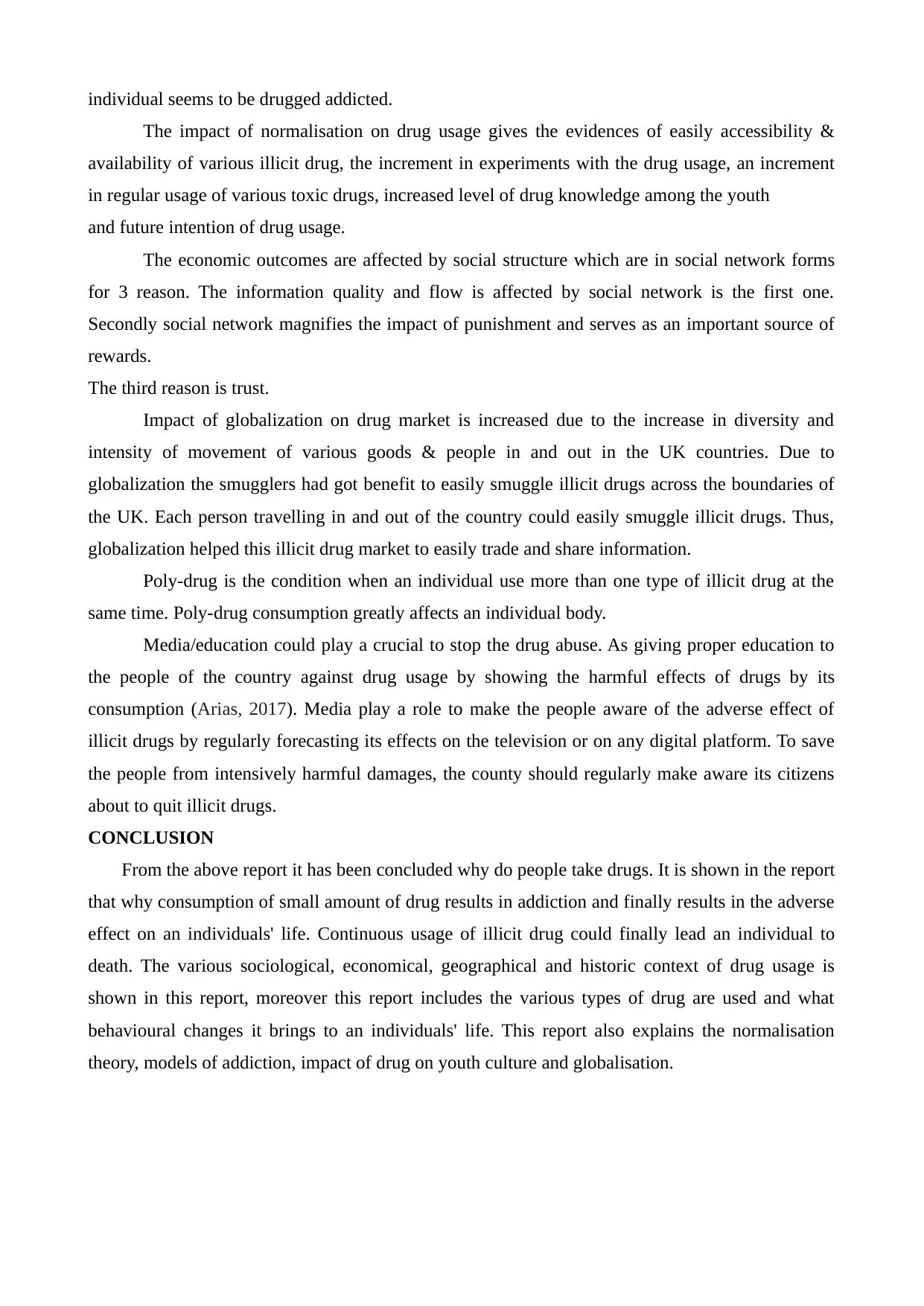
individual seems to be drugged addicted.
The impact of normalisation on drug usage gives the evidences of easily accessibility &
availability of various illicit drug, the increment in experiments with the drug usage, an increment
in regular usage of various toxic drugs, increased level of drug knowledge among the youth
and future intention of drug usage.
The economic outcomes are affected by social structure which are in social network forms
for 3 reason. The information quality and flow is affected by social network is the first one.
Secondly social network magnifies the impact of punishment and serves as an important source of
rewards.
The third reason is trust.
Impact of globalization on drug market is increased due to the increase in diversity and
intensity of movement of various goods & people in and out in the UK countries. Due to
globalization the smugglers had got benefit to easily smuggle illicit drugs across the boundaries of
the UK. Each person travelling in and out of the country could easily smuggle illicit drugs. Thus,
globalization helped this illicit drug market to easily trade and share information.
Poly-drug is the condition when an individual use more than one type of illicit drug at the
same time. Poly-drug consumption greatly affects an individual body.
Media/education could play a crucial to stop the drug abuse. As giving proper education to
the people of the country against drug usage by showing the harmful effects of drugs by its
consumption (Arias, 2017). Media play a role to make the people aware of the adverse effect of
illicit drugs by regularly forecasting its effects on the television or on any digital platform. To save
the people from intensively harmful damages, the county should regularly make aware its citizens
about to quit illicit drugs.
CONCLUSION
From the above report it has been concluded why do people take drugs. It is shown in the report
that why consumption of small amount of drug results in addiction and finally results in the adverse
effect on an individuals' life. Continuous usage of illicit drug could finally lead an individual to
death. The various sociological, economical, geographical and historic context of drug usage is
shown in this report, moreover this report includes the various types of drug are used and what
behavioural changes it brings to an individuals' life. This report also explains the normalisation
theory, models of addiction, impact of drug on youth culture and globalisation.
The impact of normalisation on drug usage gives the evidences of easily accessibility &
availability of various illicit drug, the increment in experiments with the drug usage, an increment
in regular usage of various toxic drugs, increased level of drug knowledge among the youth
and future intention of drug usage.
The economic outcomes are affected by social structure which are in social network forms
for 3 reason. The information quality and flow is affected by social network is the first one.
Secondly social network magnifies the impact of punishment and serves as an important source of
rewards.
The third reason is trust.
Impact of globalization on drug market is increased due to the increase in diversity and
intensity of movement of various goods & people in and out in the UK countries. Due to
globalization the smugglers had got benefit to easily smuggle illicit drugs across the boundaries of
the UK. Each person travelling in and out of the country could easily smuggle illicit drugs. Thus,
globalization helped this illicit drug market to easily trade and share information.
Poly-drug is the condition when an individual use more than one type of illicit drug at the
same time. Poly-drug consumption greatly affects an individual body.
Media/education could play a crucial to stop the drug abuse. As giving proper education to
the people of the country against drug usage by showing the harmful effects of drugs by its
consumption (Arias, 2017). Media play a role to make the people aware of the adverse effect of
illicit drugs by regularly forecasting its effects on the television or on any digital platform. To save
the people from intensively harmful damages, the county should regularly make aware its citizens
about to quit illicit drugs.
CONCLUSION
From the above report it has been concluded why do people take drugs. It is shown in the report
that why consumption of small amount of drug results in addiction and finally results in the adverse
effect on an individuals' life. Continuous usage of illicit drug could finally lead an individual to
death. The various sociological, economical, geographical and historic context of drug usage is
shown in this report, moreover this report includes the various types of drug are used and what
behavioural changes it brings to an individuals' life. This report also explains the normalisation
theory, models of addiction, impact of drug on youth culture and globalisation.
⊘ This is a preview!⊘
Do you want full access?
Subscribe today to unlock all pages.

Trusted by 1+ million students worldwide
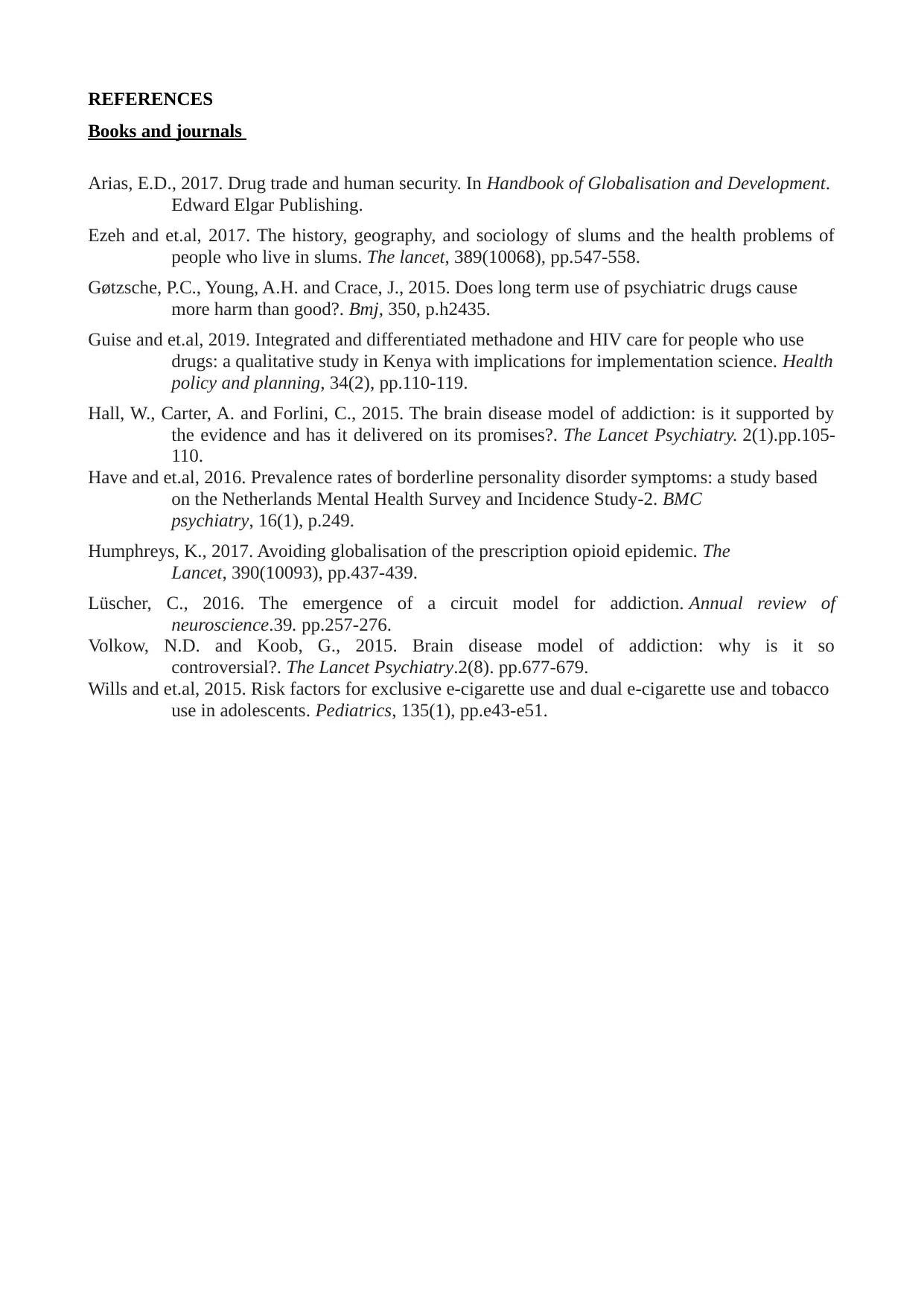
REFERENCES
Books and journals
Arias, E.D., 2017. Drug trade and human security. In Handbook of Globalisation and Development.
Edward Elgar Publishing.
Ezeh and et.al, 2017. The history, geography, and sociology of slums and the health problems of
people who live in slums. The lancet, 389(10068), pp.547-558.
Gøtzsche, P.C., Young, A.H. and Crace, J., 2015. Does long term use of psychiatric drugs cause
more harm than good?. Bmj, 350, p.h2435.
Guise and et.al, 2019. Integrated and differentiated methadone and HIV care for people who use
drugs: a qualitative study in Kenya with implications for implementation science. Health
policy and planning, 34(2), pp.110-119.
Hall, W., Carter, A. and Forlini, C., 2015. The brain disease model of addiction: is it supported by
the evidence and has it delivered on its promises?. The Lancet Psychiatry. 2(1).pp.105-
110.
Have and et.al, 2016. Prevalence rates of borderline personality disorder symptoms: a study based
on the Netherlands Mental Health Survey and Incidence Study-2. BMC
psychiatry, 16(1), p.249.
Humphreys, K., 2017. Avoiding globalisation of the prescription opioid epidemic. The
Lancet, 390(10093), pp.437-439.
Lüscher, C., 2016. The emergence of a circuit model for addiction. Annual review of
neuroscience.39. pp.257-276.
Volkow, N.D. and Koob, G., 2015. Brain disease model of addiction: why is it so
controversial?. The Lancet Psychiatry.2(8). pp.677-679.
Wills and et.al, 2015. Risk factors for exclusive e-cigarette use and dual e-cigarette use and tobacco
use in adolescents. Pediatrics, 135(1), pp.e43-e51.
Books and journals
Arias, E.D., 2017. Drug trade and human security. In Handbook of Globalisation and Development.
Edward Elgar Publishing.
Ezeh and et.al, 2017. The history, geography, and sociology of slums and the health problems of
people who live in slums. The lancet, 389(10068), pp.547-558.
Gøtzsche, P.C., Young, A.H. and Crace, J., 2015. Does long term use of psychiatric drugs cause
more harm than good?. Bmj, 350, p.h2435.
Guise and et.al, 2019. Integrated and differentiated methadone and HIV care for people who use
drugs: a qualitative study in Kenya with implications for implementation science. Health
policy and planning, 34(2), pp.110-119.
Hall, W., Carter, A. and Forlini, C., 2015. The brain disease model of addiction: is it supported by
the evidence and has it delivered on its promises?. The Lancet Psychiatry. 2(1).pp.105-
110.
Have and et.al, 2016. Prevalence rates of borderline personality disorder symptoms: a study based
on the Netherlands Mental Health Survey and Incidence Study-2. BMC
psychiatry, 16(1), p.249.
Humphreys, K., 2017. Avoiding globalisation of the prescription opioid epidemic. The
Lancet, 390(10093), pp.437-439.
Lüscher, C., 2016. The emergence of a circuit model for addiction. Annual review of
neuroscience.39. pp.257-276.
Volkow, N.D. and Koob, G., 2015. Brain disease model of addiction: why is it so
controversial?. The Lancet Psychiatry.2(8). pp.677-679.
Wills and et.al, 2015. Risk factors for exclusive e-cigarette use and dual e-cigarette use and tobacco
use in adolescents. Pediatrics, 135(1), pp.e43-e51.
1 out of 10
Related Documents
Your All-in-One AI-Powered Toolkit for Academic Success.
+13062052269
info@desklib.com
Available 24*7 on WhatsApp / Email
![[object Object]](/_next/static/media/star-bottom.7253800d.svg)
Unlock your academic potential
Copyright © 2020–2025 A2Z Services. All Rights Reserved. Developed and managed by ZUCOL.





